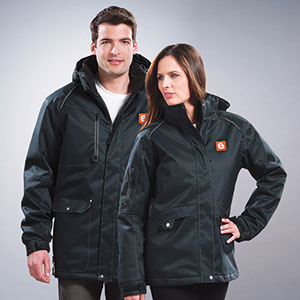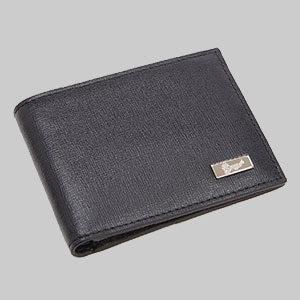Product Hub June 30, 2015
Stop Thieves With RFID Protection
To Stop A Thief RFID-Blocking Ttems Boost Personal Security.
Tollbooths, pet identification and merchandise tracking all share an increasingly common technology: a microchip bearing a tiny radio antenna that transmits data to a radio frequency scanner. It can identify a car, track a lost pet or safeguard a designer blouse.
The technology is called radio frequency identification (RFID), and it has been used since the 1970s for tagging everything from cattle to airline luggage. More recently, a form of the technology has leapt into personal items such as credit cards, bank cards and passports, many of which now incorporate smart label tags that hold data previously only visually identifiable. The U.S. government began issuing electronic passports in 2006 because they are more secure from prying eyes and enable a more efficient airport customs experience. Credit card transactions can now be accomplished with a simple swipe in front of an RFID scanner.
However, as RFID chips have proliferated, public concern has grown about a new threat of personal identification theft. The fear is that the collection of data stored in the chip, such as passport numbers and digital photographs, is a tempting target for thieves with radio frequency scanners. People theorize that credit card and bank card information may be stolen without ever leaving an individual’s purse or pocket.
“The protective material is a millimeter in thickness. Neither you nor any thieves would know that it’s there.”
Billy Bauer, Royce Leather Gifts (asi/52390)
Credit card companies have implemented their own safety measures, but experts debate their effectiveness. Meanwhile, clothing and accessory makers have deployed a simple solution that can counteract possible theft. Over the past five years, wallets, bags and even coat pockets are sold with RFID-blocking material, and their sales are picking up speed.
A.J. Dickson, global category director for bags for Polyconcept North America, says buyers for these kinds of products are growing alongside public fears of being hacked. Products available from Polyconcept through Leed’s (asi/66887) include travel bags with RFID-blocking pockets and best-selling passport wallets with RFID protection. In general, merchandise with this added feature sells better than those without it, Dickson says. “We do advertise them quite a bit,” he says. “One of our biggest brands, elleven, focuses on travel for sales professionals and other people who travel a lot. This target audience is very interested in RFID protection.”
Lately, Leed’s has begun offering bags and backpacks with additional anti-theft properties, such as split-proof zippers and hidden straps that the user can wrap around chair legs. “We’re also coming out with a few new products in August and lowering our price points so they’re more affordable,” Dickson says. He says stores such as REI are offering more products with anti-RFID features.
Similarly, Royce Leather Gifts (asi/52390) features a collection of more than 100 products with RFID-blocking technology which has been selling particularly well in the past four years, says Marketing Director Billy Bauer. More than 65% of the company’s revenue is from RFID items, which he says have become a substantial element of the company’s business. “We were getting increased demand from retailers and distributors and consumers who were exhibiting changing patterns when looking for travel accessories,” says Bauer. “At first, we were not sure how well it would take off, but we were selling 2,000 a month before we knew it.
Now there is no need to discount them,” he says. Royce’s RFID items typically cost about 10% more than its non-RFID items, which Bauer says allows the protective accessories to stay competitive on price.

The men’s (FW3220) and women’s (FW3225) critically seam-sealed jackets feature anti-RFID interior security pockets. Available from Fersten Worldwide (asi/53974; circle 78 on Free Info Card).
And as far as style goes, RFID-blocking items are physically indistinguishable from regular wallets and bags. “The protective material is a millimeter in thickness. Neither you nor any thieves would know that it’s there,” Bauer says. Some RFID-blocking materials are comprised of an amalgam of carbon and polyester material that absorbs any passing radio frequencies. Royce uses essentially a high-tech version of aluminum foil that bounces a signal back.

This bifold leather wallet(RFID128-2) from Royce Leather Goods (asi/52390; circle 77 on Free Info Card) has a thin millimeter lining that protects RFID data.
RFID-blocking properties are available in more than bags and accessories. Fersten Worldwide (asi/53974) has lately found a larger customer base for its jackets with built-in RFID protection. Launched into the market in 2014, the jackets proved to be a popular addition to their collection. “We felt a need for this on the market, and right now we are testing it. So far the feedback is great! It is very much appreciated by our customers,” says Cristina Dinica, senior marketing coordinator. The product is especially popular among youth traveling outside the country, Dinica adds.
With more people traveling after the recession a few years ago, Fersten Worldwide has seen a positive trend in sales of products that provide greater ID security. “As technology is more integrated into our lives,” Dinica says, “fears become more prevalent. With anti-RFID-enhanced products, you can have security without breaking the bank.”
Harder Than It Looks
As RFID technology has become more prevalent, there has been growing fear about the security of sensitive information like credit card and passport data. If thieves have an RFID scanner and place it in a common item like a briefcase, the worry is that they can get in close proximity to a person and scan his credit card if it’s left unprotected. In addition, it’s actually not difficult to buy an RFID scanner online, and if you’re a little tech-savvy, you can make one, says Senthilkumar CP, director of the RFID Labs at Auburn University in Alabama. They can even be found on eBay.
However, even without a protective lined wallet, security experts say it’s possible but unlikely that someone will steal usable information from a financial card or passport. Though a reader could scan the RFID chip, the thief would also need the authorization codes to make sense of the information derived, CP says. “The chips have a lot of security,” he says. “You not only have to have the right devices to read it, you need the right decoding information on hand. It’s like having to know a person’s username and password to read their email. Just having the hardware, the computer, is not enough.”
The key element of RFID technology is its short-range read protocol, says Tom O’Boyle, director of RFID at Barcoding Inc., which provides systems integration for RFID hardware and software. “Using the magnetic field of the RFID tag, the technology relies on the reader’s power to energize the chip and reflect energy back. Because of interference in the real world, you have to be about two to four inches away,” O’Boyle says. “For example, in the case of an employee ID badge with an RFID tag, you have to scan it an inch away from the reader pad, because the magnetic field coupling them together is weak. For theft, someone has to be in your personal space to capture that energy.”
When you take into consideration that passports now come with a metallic sleeve that hinders unwanted scans, the reader has to get within a quarter of an inch to have any hope of reading the chip, he says.
Nevertheless, RFID experts cannot say that theft is impossible, so a specially lined bag or wallet offers additional security for minimal extra cost.
Manasee Wagh is a contributing writer for Wearables.

Product Hub
Find the latest in quality products, must-know trends and fresh ideas for upcoming end-buyer campaigns.
